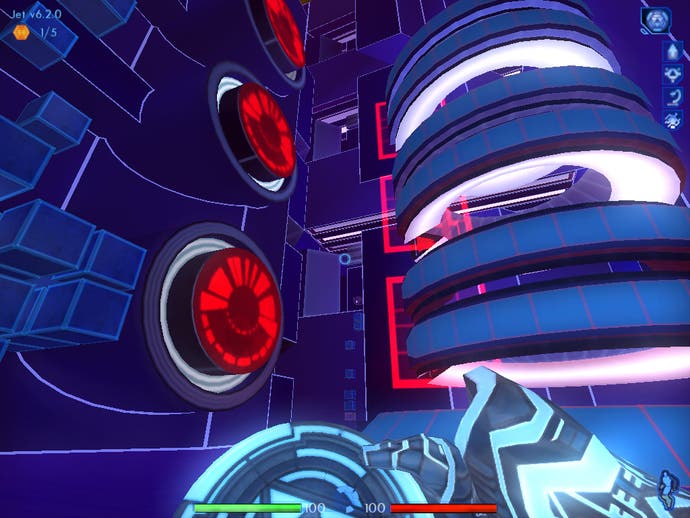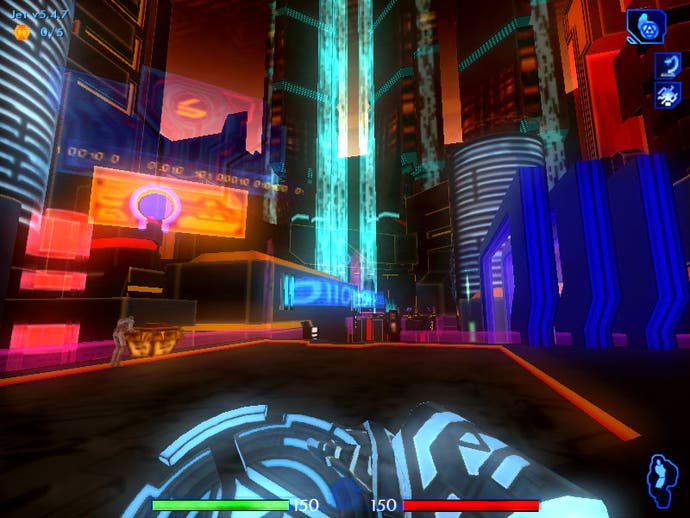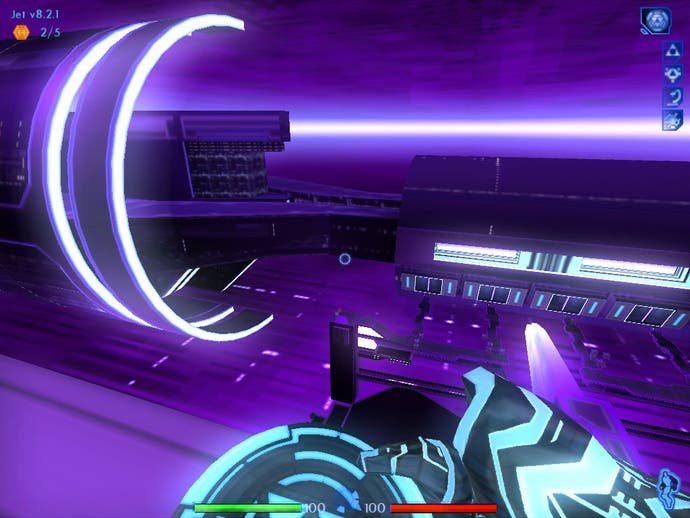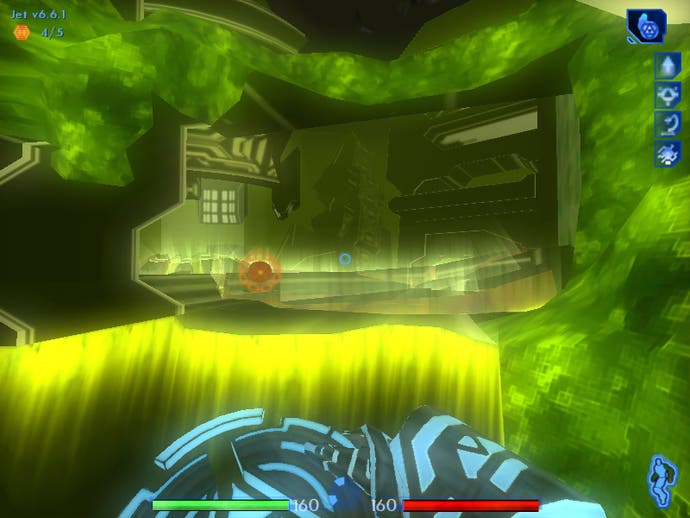Tron 2.0
When we get bored of Martin, we try to fit him inside the computer. Sadly, he won't fit through the floppy port. This will have to do.
If you haven't seen the movie, you're probably going to wonder what all the fuss is about. Tron was a beautiful film that likely wouldn't get more than a passing glance from Hollywood-loving oiks these days, but if you grew up with it like me, then the very prospect of experiencing Disney's unusual adventure from the inside would be impossible to pass up.
Ahead of its time

Tron 2.0 picks up twenty years after the original movie, and you assume the role of Jet, the son of Alan Bradley. Alan (or Alan 1 as Tron referred to his "user" twenty years ago) still works for Encom - the company rescued from the clutches of the megalomaniacal Master Control Program - and is working on the verge of replicating the digitising technology that beamed Kevin Flynn into the computer to do battle with the MCP and eventually take control of the company.
Meanwhile, Encom is on the verge of corporate takeover from Future Control Industries. Of course, fCon has an ulterior motive and plans to utilise Alan's discovery to digitise specially trained hackers - or DataWraiths - to steal data and passwords from the world's networks from the inside.
The missing link for fCon is Alan's advanced AI, Ma3a (pronounced mah-three-ah), which is capable of storing the genetic makeup of a human in its memory and the algorithms required to restore one back into reality. The mysterious disappearance of Alan at the hands of fCon catches his wayward son's attention; Ma3a takes the initiative when Jet quizzes her on the situation, and beams him into the computer realm to protect her. This is where you come in, guiding Jet through the system riddled with virii in an attempt to avoid infection (as any strapping young chap should), protect Ma3a from fCon, and locate his father.
Electric light parade

It's the visuals that strike you first. Of course it is - the basic colours synonymous with Tron's visual representation of computer reality bind with the chunky and wholly bizarre architecture to form a style that never fails to leave its mark. The graphics don't sound so good in words, and you can't even begin to appreciate how great it looks from still shots but trust us: it just works, like some kind of bastard offspring of Rez and No One Lives Forever.
Monolith has translated the Tron aesthetic to the Litchtech engine with incredible accuracy; the subtly glowing colours, the geometric structures, the throbbing beams of light and skymaps of overlaid Tetris blocks all gel flawlessly from the very start. It's because of this that within ten minutes we had crowned Tron 2.0 "the best game ever" and started taking screen grabs to show our utterly indifferent friends [it's true -utterly indifferent friends]. Again, if you haven't seen the film...
But still, we spent our first moments grinning to ourselves and exclaiming aloud just how cool it all was. It's not really the gameplay - it's just that of all the fantasy worlds we've found ourselves stuck in throughout our many years of gaming, Tron 2.0's feels so much fresher and distinctly individual. Everything oozes (artificial) life. Virtually every character is voiced and animated to great effect, and even your occasional companion Byte shows great personality - and he's a chunky ball with spikes that throb when he speaks.
Augmented

But how does it play? Tron 2.0 is a very simple, very harmless FPS at heart and the distinctions between this and your average common-or-garden shooter are subtle. We can start with the fact that Jet can't simply let rip with any weapon he gets his hands on (and there aren't even that many to speak of), because every shot of a weapon other than his ubiquitous disc will sap his energy levels. The emphasis is very much on considered choice of weaponry, but because of this very fact we mostly just made use of the disc and its various deviations found throughout the game, and the LOL sniper rifle. Yes, LOL.
Then there's the almost RPG-like version points system, which rewards exploration and objective completion by adding points to Jet's overall version number. Once his number jumps up a level (from v2.9.9 to v3.0.0 for example), you're then able to customise his abilities slightly. We say slightly because many of the adjustments - weapons efficiency (which reduces energy usage per shot), transfer speed and processing speed (more on those two in a second) for example - don't have that huge a bearing on how you end up playing.
The processing and transfer speeds are linked to the final feature which sets Tron 2.0 apart from many of its FPS peers - subroutines. Subroutines are upgrades, which Jet can apply in very much the same vein as JC's augmentations in Deus Ex. By searching shimmering archive bins that litter each level, it's usually possible to pick up an upgrade to your overall program which can imbue Jet with a new talent, such as higher jumping, virus protection or even new weapons. Each subroutine comes in incrementing Alpha, Beta and Gold states, which improve the effectiveness of each skill at each stage. Adjustments to your transfer speed ability upon levelling up will allow you to extract data from archive bins faster, while higher processing speeds will allow Jet to disinfect and bad clusters defrag (two symptoms of virus infection), and decrypt unknown subroutines in his memory much faster.
The management of the subroutines resident in your memory gradually becomes a more and more integral part of the game the further you get. You will find yourself getting comfortable with a few firm favourites and the best way to organise them in your memory's limited space becomes second nature.
And for my next trick...

It's not just extra talents tucked away in archive bins either. With the exception of between-level scenes, the plot and back-story is pushed along quite nicely with snatches of real-world e-mail exchanges, memos and even the occasional video archive. You'll also find permissions tucked in the archives. Permissions are Tron 2.0's coloured keycards, and Jet has space for a set of eight to help him get around the levels. Different combinations of which will grant him access to different areas - get a full set of permissions though and he has the run of the level, able to shut down security spawn points (or rezzing stations as they're known), search any archive and waltz through any old door.
So instead of radically altering the genre, or even blurring the boundaries between genres, it's the neat little tricks that Tron 2.0 pulls that save it from plain old FPS drudgery. The gameplay isn't short on showpieces either, from the initial virus infestation (of which you are mistakenly accused of being the source) cracking and drenching otherwise pristine areas of system in a fluorescent green haze, to the eventual system format which removes the infection and results in your panicked attempt to escape deletion.
Oh yes, and how could we forget the lightcycles? The race sequences from the film have been turned into a fully-fledged feature for both the single and multiplayer modes. During the single-player adventure, the cycle sections break up the shooting just when you think it's about to become monotonous, and you're flung into a breakneck, last-man-standing version of Snake that slots into the story quite conveniently. The ridiculously competent reaction speeds of the AI can render the races horrendously frustrating at times, but the cycle races are still one of the game's many highlights.
Perhaps the only thing that's sorely missing from the title was the ability to pilot any of the other vehicles from the film. Sure, the tanks and recognizer crafts were present and correct, making all the right moves and all the right noises, but we really wanted to clamber aboard and bash against the walls, with a Bit yelling "No! No! No! No! No! No! No! No!" in our ears. Any other criticisms? Perhaps the seemingly unavoidable Quick Save/Quick Load syndrome that plagues most PC shooters - the way many sections work you'll almost certainly have to indulge in a spot of trial and error, reloading until you get it just right. The AI of most enemies is also a little rubbish at times, with 'tactics' boiling down to their hiding behind blocks until you come for them, or running straight after you until they inevitably derez thanks to you thwacking them about the bonce with your mighty disc of whoop.
Don't knock it until you've tried it
Tron 2.0 is a grand achievement for Monolith. The team has managed to combine more or less everything a Tron fan ever wanted from a Tron game with the mechanics that made the NOLF series so loveable, to come up with a fabulous, compelling action title. It certainly isn't going to win any awards for pushing the envelope, but it's a damn sight better than most of the generic FPS tripe we've seen pass through the office over the last year or so.
We really can't find many reasons to knock it. Tron 2.0 could've used just a bit more adventurous deviation in the gameplay - perhaps with the employ of more vehicles or the opportunity to experience other character roles - but it's stylish, fun, challenging and you really do feel as if you're playing a part in a sequel to a cult classic. That's all we were after.








